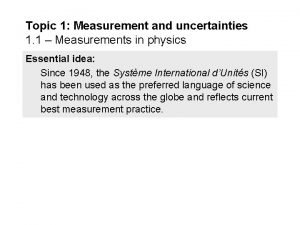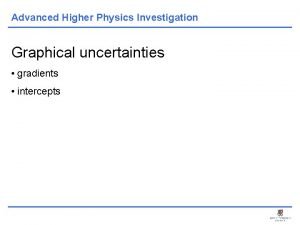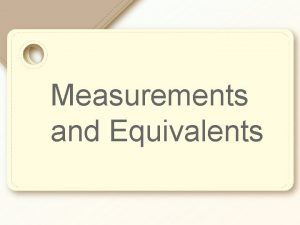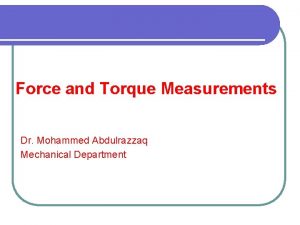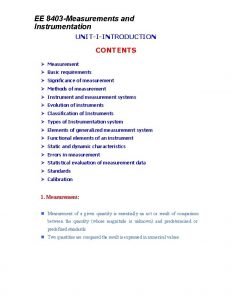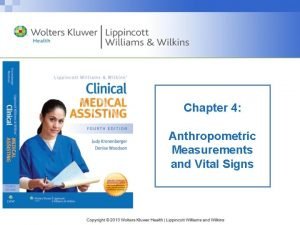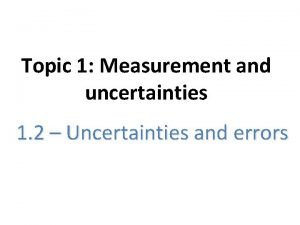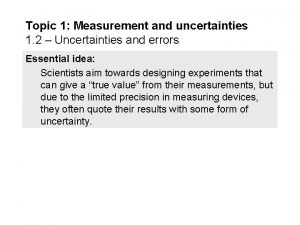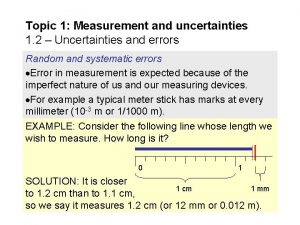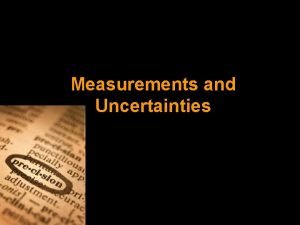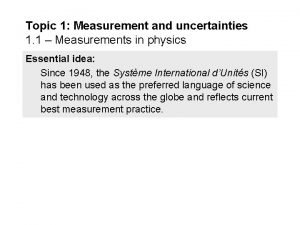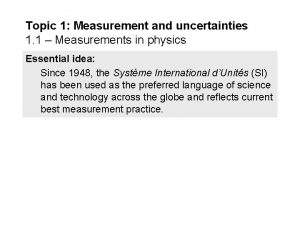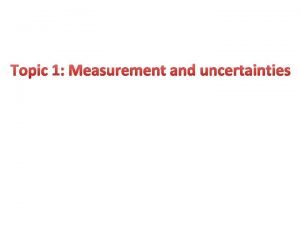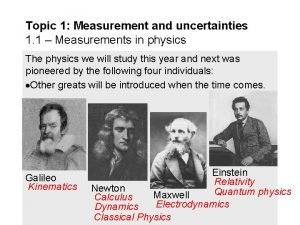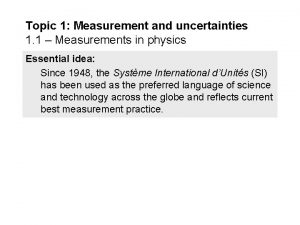Topic 1 Measurement and uncertainties 1 1 MEASUREMENTS












- Slides: 12

Topic 1: Measurement and uncertainties 1. 1 – MEASUREMENTS IN PHYSICS

Essential idea: Since 1948, the Système International d’Unités (SI) has been used as the preferred language of science and technology across the globe and reflects current best measurement practice. Nature of science: (1) Common terminology: Since the 18 th century, scientists have sought to establish common systems of measurements to facilitate international collaboration across science disciplines and ensure replication and comparability of experiments. (2) Improvement in instrumentation: Improvement in instrumentation, such as using the transition of cesium-133 atoms for atomic clocks, has led to more refined definitions of standard units. (3) Certainty: Although scientists are perceived as working towards finding “exact” answers, there is unavoidable uncertainty in any measurement.

Understandings: ▪ Fundamental and derived SI units ▪ Scientific notation and metric multipliers ▪ Significant figures ▪ Orders of magnitude ▪ Estimation Applications and skills: ▪ Using SI units in the correct format for all required measurements, final answers to calculations and presentation of raw and processed data ▪ Using scientific notation and metric multipliers ▪ Quoting and comparing ratios, values and approximations to the nearest order of magnitude ▪ Estimating quantities to an appropriate number of significant figures Guidance: ▪ SI unit usage and information can be found at the website of Bureau International des Poids et Mesures ▪ Students will not need to know the definition of SI units except where explicitly stated in the relevant topics ▪ Candela is not a required SI unit for this course ▪ Guidance on any use of non-SI units such as e. V, Me. V c-2, Ly and pc will be provided in the relevant topics

International-mindedness: ▪ Scientific collaboration is able to be truly global without the restrictions of national borders or language due to the agreed standards for data representation Theory of knowledge: ▪ What has influenced the common language used in science? To what extent does having a common standard approach to measurement facilitate the sharing of knowledge in physics? Utilization: ▪ This topic is able to be integrated into any topic taught at the start of the course and is important to all topics ▪ Students studying more than one group 4 subject will be able to use these skills across all subjects Aims: ▪ Aim 2 and 3: this is an essential area of knowledge that allows scientists to collaborate across the globe ▪ Aim 4 and 5: a common approach to expressing results of analysis, evaluation and synthesis of scientific information enables greater sharing and collaboration

Topic 1: Measurement and uncertainties 1. 2 – Uncertainties and errors

Essential idea: Scientists aim towards designing experiments that can give a “true value” from their measurements, but due to the limited precision in measuring devices, they often quote their results with some form of uncertainty. Nature of science: Uncertainties: “All scientific knowledge is uncertain. When the scientist tells you he does not know the answer, he is an ignorant man. When he tells you he has a hunch about how it is going to work, he is uncertain aparamount importance, in order to make progress, that we recognize this ignorance and this doubt. Because we have the doubt, we then propose looking in new directions for new ideas. ” – Feynman, Richard P. 1998. The Meaning of It All: Thoughts of a Citizen-Scientist. Reading, Massachusetts, USA. Perseus. P 13.

Understandings: • Random and systematic errors • Absolute, fractional and percentage uncertainties • Error bars • Uncertainty of gradients and intercepts Applications and skills: • Explaining how random and systematic errors can be identified and reduced • Collecting data that include absolute and/or fractional uncertainties and stating these as an uncertainty range (expressed as: best estimate ± uncertainty range) • Propagating uncertainties through calculations involving addition, subtraction, multiplication, division and raising to a power • Determining the uncertainty in gradients and intercepts

Guidance: • Analysis of uncertainties will not be expected for trigonometric or logarithmic functions in examinations Data booklet reference: • If y = a b then y = a + b • If y = a · b / c then y / y = a / a + b / b + c / c • If y = a n then y / y = | n · a / a | Theory of knowledge: • “One aim of the physical sciences has been to give an exact picture of the material world. One achievement of physics in the twentieth century has been to prove that this aim is unattainable. ” – Jacob Bronowski. • Can scientists ever be truly certain of their discoveries? Jacob Bronowski was a mathematician, biologist, historian of science, theatre author, poet and inventor. He is probably best remembered as the writer of The Ascent of Man.

Utilization: • Students studying more than one group 4 subject will be able to use these skills across all subjects Aims: • Aim 4: it is important that students see scientific errors and uncertainties not only as the range of possible answers but as an integral part of the scientific process • Aim 9: the process of using uncertainties in classical physics can be compared to the view of uncertainties in modern (and particularly quantum) physics

Topic 1: Measurement and uncertainties 1. 3 – Vectors and scalars

Essential idea: Some quantities have direction and magnitude, others have magnitude only, and this understanding is the key to correct manipulation of quantities. This sub-topic will have broad applications across multiple fields within physics and other sciences. Nature of science: Models: First mentioned explicitly in a scientific paper in 1846, scalars and vectors reflected the work of scientists and mathematicians across the globe for over 300 years on representing measurements in threedimensional space. Understandings: • Vector and scalar quantities • Combination and resolution of vectors Applications and skills: • Solving vector problems graphically and algebraically

Guidance: • Resolution of vectors will be limited to two perpendicular directions • Problems will be limited to addition and subtraction of vectors and the multiplication and division of vectors by scalars International-mindedness: • Vector notation forms the basis of mapping across the globe Theory of knowledge: • What is the nature of certainty and proof in mathematics? Utilization: • Navigation and surveying (see Geography SL/HL syllabus: Geographic skills) • Force and field strength (see Physics sub-topics 2. 2, 5. 1, 6. 1 and 10. 1) • Vectors (see Mathematics HL sub-topic 4. 1; Mathematics SL sub-topic 4. 1) Aims: • Aim 2 and 3: this is a fundamental aspect of scientific language that allows for spatial representation and manipulation of abstract concepts
 Measurements and uncertainties ib physics
Measurements and uncertainties ib physics Absolute uncertainty multiplication
Absolute uncertainty multiplication Higher physics uncertainties
Higher physics uncertainties Advanced higher physics uncertainties
Advanced higher physics uncertainties Pee writing strategy
Pee writing strategy Topic about internet
Topic about internet Maps and scales maths lit grade 11
Maps and scales maths lit grade 11 Measurements equivalents and adjustments
Measurements equivalents and adjustments Chapter 2 measurements and calculations
Chapter 2 measurements and calculations Force and torque measurements
Force and torque measurements Ee8403 measurements and instrumentation
Ee8403 measurements and instrumentation Temperature is an anthropometric measurement
Temperature is an anthropometric measurement Vital signs and body measurements quiz
Vital signs and body measurements quiz
